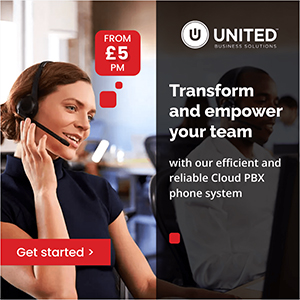Blog, VoIP & Hosted PBX
Complete Guide to Virtual Landlines: Transform Your Business Communication
Imagine a world where your business communication is not tethered to a specific location or device. A world where your landline number is as mobile as you are, and your clients can reach you whether you are in your office, on the move, or working remotely. You also have the freedom to select a number that builds the right impression in the eyes of your customers and suits your communication strategy.
Welcome to the world of virtual landlines, a rising wave in business communication. Discover the technology that makes it all possible, how virtual landlines work, their benefits and possibilities with our guide to virtual landlines.
Key Takeaways
- Versatility and cost-effectivness: Virtual landlines cater to a broad range of business needs, from small startups to large enterprises, offering cost-effective communication solutions with no need for expensive hardware.
- Professional image and call management features: These systems enhance a business’s professional image with a variety of number options and improve customer interactions with advanced features like call forwarding, voicemail-to-email, and custom greetings.
- Seamless integration and transition: Setting up a virtual landline is an easy process, and it can integrate effortlessly with many existing business systems. It also allows for a straightforward transition from traditional phone systems, supporting existing number porting and access via a variety of devices.
- Reliability, security and compliance: With the right infrastructure in place, a virtual landline can be integrated into your communication workflow while ensuring you maintain uninterrupted and compliant communications.
Table of Contents
- Exploring Virtual Landline Technology
- Uses for Virtual Landlines and Virtual Number
- Benefits of Switching to a Virtual Landline
- Transitioning from traditional phone systems to virtual landlines
- Navigating Potential Challenges with Virtual Landlines
- Final thoughts on virtual landlines
- Frequently asked questions about virtual landlines
Exploring Virtual Landline Technology
The appeal of a virtual landline lies in its ability to act as a cloud-based phone system that releases you from the limitations of a traditional landline. It offers numerous advantages compared to an analogue telephone line, including cost savings, mobility, scalability and more.
Businesses can also choose from a range of virtual phone numbers, such as local numbers, national numbers, freephone numbers, and memorable numbers to align with their operational and marketing strategies.

What is a virtual landline?
A virtual landline number utilises VoIP technology to facilitate call transmission over the internet. Unlike the traditional copper landlines, virtual landlines require no physical equipment to function and rely on a stable internet connection (such as fibre, LTE/4G, 5G, ADSL, wireless or satellite).
How does a virtual landline work?
Under the hood, virtual landlines use VoIP technology to transform voice signals into digital signals and direct these calls through the internet.
Based on this setup, virtual landlines can be used in a variety of ways to streamline and scale business communications for sole proprietors, startups and large enterprises.
They can be associated with a variety of numbers, including geographic and non-geographic numbers. They can be configured based on your needs and preferences, and utilise a number of call management features associated with cloud telephony.
Uses for Virtual Landlines and Virtual Numbers
Virtual landline numbers can be accessed and utilised in various ways to enhance communications for businesses of different sizes across niches.
Let’s explore how different business types leverage virtual landlines for their specific needs.

Startups & SMEs
For startups and small to medium-sized enterprises (SMEs), virtual landlines are a game-changer. These businesses often operate with limited budgets and need scalable solutions that can adapt as they grow. Virtual landlines eliminate the need for expensive hardware and physical phone lines, reducing upfront costs. They allow SMEs to project a professional image with features like custom greetings, call forwarding, and voicemail, all manageable through an easy-to-use interface. As the business expands, additional lines or features can be added with minimal hassle, ensuring that the communication infrastructure grows in tandem with the company.
Sole Proprietors and Micro-Entrepreneurs
For sole proprietors and micro-entrepreneurs, maintaining a clear boundary between personal and business communications is crucial. Virtual landlines provide a distinct, dedicated business phone number that can be used on existing devices, negating the need for a separate business phone if this is your desired preference. This setup is ideal for home offices or for entrepreneurs who are often on the move, as it ensures they never miss important calls and maintain a professional demeanour in their communications. The flexibility to manage calls through a smartphone or computer allows for a seamless transition between work and personal life.
Large Enterprises with National or International Reach
Large enterprises, especially those with a national or international presence, benefit significantly from virtual landlines. They can utilise a local number in different region or a non-geographic number to establish a local presence and build customer trust, regardless of where their offices are physically located. This local presence can be crucial for customer engagement and brand perception, making businesses appear more accessible to their target audience. Additionally, features like call routing to various departments and integration with existing corporate systems make virtual landlines an integral part of their global communication strategy.
Remote Workers and Freelancers
In today’s flexible work environment, remote workers and freelancers need communication tools that are as mobile and adaptable as they are. Virtual landlines allow them to receive calls from anywhere, using any internet-enabled device. This mobility ensures that they maintain a professional image with a consistent business number, regardless of their changing work locations. Features like call forwarding, voicemail-to-email, and the ability to set business hours for call reception further enhance their work-life balance and professional productivity.
Customer Service Centers
Customer service centers, which handle a high volume of calls, find virtual landlines indispensable for their operations. These systems allow for sophisticated call routing based on time, caller location, or nature of inquiry, ensuring that calls are efficiently directed to the appropriate agent or department. This streamlined call management reduces wait times and improves customer satisfaction. The scalability of virtual landlines means that as call volumes fluctuate or the business grows, the infrastructure can be adjusted quickly and easily to meet these changing demands.
Benefits of Switching to a Virtual Landline
Adopting a virtual landline allows you to unlock a treasure trove of advantages. It’s not just about making and receiving calls; it’s about unlocking a world of possibilities enabled by VoIP and cloud telephony that transforms the way businesses communicate.
From cost savings attributed to cheaper call rates and the lack of hardware requirements to powerful call management features for enhancing your workflow for incoming and outbound calls, and much more – virtual landline telephony helps businesses across niches redefine their approach.
Let’s explore the range of benefits virtual landlines have to offer your business.

Cost-Effective Solutions for Businesses)
By eliminating the costly hardware and maintenance requirements, virtual landlines offer affordable communication solutions for businesses. Virtual landlines utilise VoIP technology, enabling calls to be made and received via the internet using existing devices. The cost of implementing a traditional landline can vary a few hundred to a thousand pounds when purchasing an installing a traditional PBX system.
Conversely, virtual landlines negate the necessity for such costly infrastructure, leading to a significant reduction in these expenditures. A single virtual landline may cost anywhere from 10-20 pounds per month depending on the provider and what is included.
A business looking to set up a virtual landline usually only has to worry about having a stable internet connection, picking the right provider and package and selecting their device of choice for managing calls.
A virtual landline is far more versatile and economical than a traditional telephone line. By being hosted in the cloud, it is easily accessible anywhere and provides a set of features and benefits worthwhile for businesses of all sizes.
Boosting Professional Image with Global or Local Presence
In the realm of business, perception holds paramount importance. A global or local number can significantly enhance a business’s professional image for customers. For instance, a location-specific or national virtual landline telephone number can enhance the professional image of a business, increasing trust in the eyes of customers.
Using a local area code can:
- Instill a feeling of familiarity and accessibility for consumers
- Lead to a sense of community and trust
- Result in increased comfort and loyalty towards the business
It’s like building a virtual storefront in the customer’s neighborhood, providing a sense of local presence and accessibility.

Fleet of standard and advanced communication features
The use of virtual landlines extends beyond merely making and receiving calls. They offer a fleet of standard and advanced communication features that can streamline business operations and enhance customer service. These features encompass:
- Call management and flexibility for both incoming and outgoing calls
- Voicemail and call forwarding options
- Call recording and analytics
- Interactive voice response (IVR) systems
- Conference calling capabilities
These features enable businesses to effectively manage their communication and improve their overall efficiency.
Imagine having the power to:
- Direct incoming calls to the right department or person
- Screen calls for prioritisation
- Maintain call queues for efficient handling
- Have a virtual receptionist to enhance customer service
All these features come bundled with a virtual landline, making it a powerful tool in the arsenal of any business.
Integrations with business software and hardware
The flawless integration of virtual landlines with the existing business software and hardware stands as one of their primary benefits. By integrating virtual landlines with business software, companies can:
- Optimise communication processes by facilitating automatic call logging
- Synchronise contacts
- Leverage CRM integrations to improve customer support and sales operations.
Moreover, virtual landlines are compatible with a range of hardware devices, such as IP desk phones, mobile and landline phones (equipped with VoIP adapters), and desktop softphone applications, offering adaptable and multifaceted communication capabilities. The integration process is akin to assembling a puzzle piece, ensuring a harmonious and efficient communication system that complements the business’s existing infrastructure.
Transitioning from traditional phone systems to virtual landlines
When transitioning from a traditional phone system to a virtual landline, a business will can enjoy the modern features associated with VoIP telephony, while retaining its current office number or choosing to select a new one. Plus, with most providers, you can integrate with existing business systems and software to make the process as seamless as possible.
Let’s discuss transitioning from a traditional phone system to a virtual landline in more detail.

Assessing existing infrastructure, software and hardware
Before transitioning to a virtual landline or another VoIP-based system, a business should take stock of its existing hardware and software systems to assess their compatibility with a new system.
With most providers, software solutions such as CRMs are easy to integrate with a virtual landline, however hardware needs to be more carefully considered. For example, landline phones need to be equipped with a VoIP adapter in order to manage calls, or if you plan on taking your virtual landline with you may choose to utilise call forwarding or the use of a softphone extension on a mobile phone.
The good news is that this assessment should be quite straightforward, and the way you plan to utilise your virtual landline will be the largest influence on the hardware you require. Your virtual landline provider can also help you determine the best course of action for integrating existing software and hardware. If you’re looking for help, you can always contact a specialist from our team.
Setting up a virtual landline
We cover all aspects steo by step on how to setup a virtual landline and landline to VoIP number porting (a part of the process) in our related articles. Here’s a summary of the steps you’ll need to get your business up and running with a virtual landline:
- Research and choose your virtual landline provider: including options like BT virtual landline, Vonyage, RingCentral, 8×8, bOnline or United Telecoms.
- Port your number or select a new virtual phone number: geographic, non-geographic, national, mobile, international and more.
- Set up your account and pay for your plan.
- Install softphone extension app or integrate IP-enabled handsets. Integrate with existing business software.
- Configure settings and features for call management.
Navigating Potential Challenges with Virtual Landlines
Despite the myriad benefits of virtual landlines, as with any technology, they present their unique set of challenges. Potential challenges include network reliability, regulatory compliance, and security.
Let’s explore these challenges and solutions to help you ensure that you have the best possible experience with your virtual landline service.

Network reliability & redundancies
A reliable network will guarantee uninterrupted communication, critical for sustaining business activities and ensuring customer satisfaction. The critical elements that contribute to network reliability include:
- Adequate bandwidth
- A dependable internet connection
- High call quality
- Compatibility with the virtual landline system
- Scalability to meet the expanding demands of the business.
Virtual landline providers ensure network redundancies by:
- Implementing backup systems
- Connecting to multiple carriers
- Separating the transmission of voice data from other data submitted by applications over a network using a VLAN.
- Maintaining service continuity in the event of outages or disruptions by utilising virtualisation technology to create virtual instances of their network equipment.
Businesses can ensure network reliability by considering their own network infrastructure, and by choosing a trusted provider that maintains maximum uptime and has redundancies in place to maintain continuity.

Regulatory compliancer
The regulatory standards for virtual landlines can differ based on the country and region. To ensure compliance, businesses should:
- Select a reputable virtual landline provider that emphasises regulatory compliance and security measures
- Gain an understanding of specific regulations
- Establish a data inventory
- Develop and implement compliance policies
- Provide training to employees
- Conduct regular audits
Failure to comply with these regulations can lead to penalties including fines, legal proceedings, and potential service suspension. The stringency of regulatory compliance can depend on the size of the business and its operations. Particularly if you are operating in healthcare, financial services, legal, ecommerce or government services, this aspect may be important.
Security
In the age of digital communication, security is as essential as seatbelts in a car. While using virtual landlines, businesses may potentially face multiple security threats, including:
- Eavesdropping
- Phishing
- DDoS attacks
- Call tampering
- Susceptibility to malware and viruses
Virtual landline providers ensure data security by implementing various measures, including the use of access lists to prevent information theft, encrypting data transmission, and implementing security protocols to protect against unauthorised access. Encryption in virtual landlines involves the transformation of voice data packets into complex, unrecognisable patterns as they move from the source to the destination, guaranteeing the security of voice data and preventing unauthorised access.
Businesses can ensure the security of their virtual landline by:
- Utilising a service provider with strong security measures
- Implementing robust authentication
- Consistently updating and patching software
- Utilising a VPN for encrypting communications
- Deploying firewall and intrusion detection systems
Final thoughts on virtual landlines
It’s clear that virtual landlines are not just a trend, but a game-changing solution for business communication. They offer cost-effective, flexible, and reliable communication solutions, packed with advanced features and seamless integrations. From micro-entrepreneurs to large enterprises, businesses of all sizes can harness the power of virtual landlines to revolutionise their communication, enhance their professional image, and drive their success.
We urge businesses to contact us and consult with an expert if you are considering setting up a new virtual landline or transitioning from a traditional PBX system to VoIP (Voice over Internet Protocol) telephony. As a trusted provider of business telephony solutions through the United Kingdom, we can help you set up a virtual landline that meets your needs and suits your preferences.
Frequently asked questions about virtual landlines
Virtual landline telephone numbers in the United Kingdom typically cost between 10-20 GBP per month depending on the provider and the plan.
Our virtual landline packages start at 8 GPB per month, making them an affordable and convenient option for micro-entrepreneurs, small businesses and large enterprises.
Virtual landline numbers provide numerous benefits cost savings, increased flexibility, effortless scalability, and create value by creating a trustworthy impression with a localised geographic number or a non-geographic number to create a professional impression not limited to a specific region.







Got questions? Contact our experts today.
We service the following locations across London and the United Kingdom
Greater London: City of London, Hounslow, Barking and Dagenham, Islington, Barnet, Kensington and Chelsea, Bexley, Kingston upon Thames, Brent, Lambeth, Bromley, Lewisham, Camden, Merton Croydon, Newham, Ealing, Redbridge, Enfield, Richmond upon Thames, Greenwich, Southwark, Hackney, Sutton, Hammersmith and Fulham, Tower Hamlets, Haringey, Waltham Forest, Harrow, Wandsworth, Havering, Westminster and Hillingdon.
What Our Customers Say
“Once we approved the installations we were kept up to date daily with the levels of progress on our various sites and were very impressed with the final installation”
Spear Properties
Get In Touch
London Office
2 Osborne Way
Epsom
Surrey
KT19 8GR
United Kingdom (UK)
Tel: 033 1630 0516
Tel: 020 3399 8011
Email: info@united-telecoms.co.uk
We're the experts so that you don't need to be!
PBX Phone System
Beginner's Guide
Voice & Hosted PBX
Resources
PABX Relocation and
Reinstallation
PBX Phone System
Resources